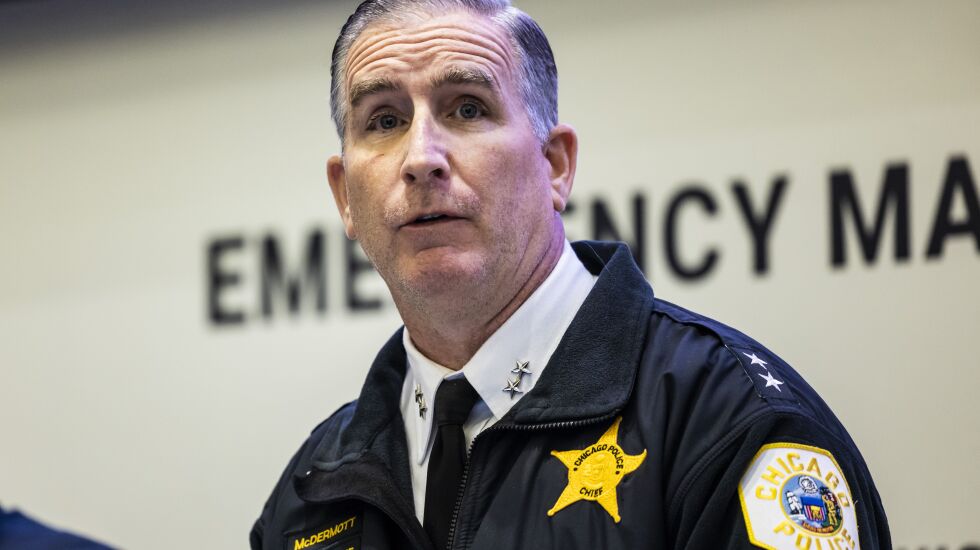
A top Chicago police official said Friday the department’s “priority No. 1” is getting a handle on large gatherings downtown that have devolved into chaos and damaged the city’s reputation.
During a news conference detailing the city’s summer safety plan, Chief of Patrol Brian McDermott acknowledged that the Chicago Police Department was caught flat-footed when groups of young people descended on the Loop on April 15.
Two teenage boys were shot as fights erupted, and vehicles were damaged during the so-called teen trend event, which was promoted on social media. Cellphone video of a couple being attacked by a mob of people went viral, prompting national news coverage.
McDermott said the “perfect storm” that night was a learning experience and promised that more cops are now being deployed downtown.
But he acknowledged, “It’s never going to look pretty” when these types of gatherings happen.

“If we have 500 to 1,000 teens running around downtown, we can have the best plan in place, but it’s still going to look pretty chaotic,” he said at the headquarters of the city’s Office of Emergency Management and Communications. “But I think we can do a better job of managing the resources and taking the right individuals into custody and try and keep people safe downtown.”
McDermott said the department has “significantly increased” its presence at Millennium Park, which has become a meeting spot for groups of young people who have wreaked havoc downtown.
Seandell Holliday, 16, was shot and killed at the park during a gathering in May 2020, prompting a curfew that bans minors from entering the park without an adult between Thursday and Sunday nights.
McDermott said police officials and security guards are checking bags at the park and at beaches and that youth programming is being expanded to provide “safe spaces” for kids.
“I don’t think anyone here is suggesting that we go out and lock up every teen that’s downtown dancing in the middle of the street,” he said. “I think what we can do better is do a better job of identifying those who are engaged in criminal activity and placing those individuals in custody.”
McDermott said officers will be flooding the city’s 75 most dangerous police beats, which he said account for 75% of the city’s violence. He credited a similar strategy that focused on 55 beats for helping lower key markers of violent crime.
The number of shootings and homicides have continued to fall this year, both dropping 9% through April 23, according to the police department’s latest public crime data. Crime is up 45% overall.
Police areas across the city are implementing “individualized plans” to address crime and security around entertainment venues and retail corridors, McDermott said. There also will be an increased presence on CTA buses and L trains to help ensure that riders are safe, he said.
Strained police resources will likely be stretched thinner by a steady stream of special events bringing scores of tourists to the city, like the Lollapalooza music festival and the NASCAR street race downtown.
Staffing has been a pervasive problem within the department in recent years, with former police Supt. David Brown coming under fire for routinely canceling days off to cover shifts.
The police department has been placed at the center of the city’s response to a growing humanitarian crisis, with many district stations now doubling as makeshift shelters for a flood of new immigrants.
Mayor Lori Lightfoot’s office has pushed the department to use CAPS officers from the Office of Community Policing to transport new arrivals, handle intake and conduct security at shelters, according to a law enforcement source.

Tina Skahill, the police department’s reform chief, informed CAPS leaders Tuesday that some officers were being moved, sources said. Typically tasked with bridging the gap between the department and the community, CAPS officers are already being sent downtown to supplement low staffing levels in patrol and to brace for potential violence or youth gatherings, the law enforcement source said.
During a contentious meeting Thursday about the city’s plan to move new arrivals into the shuttered South Shore High School, Skahill tried to address safety concerns by noting that officers would patrol the proposed shelter space around the clock and increase surveillance.
A department spokesperson said the changes won’t have cascading effects, insisting “sufficient resources and staffing in place to maintain public safety now and throughout the summer.”







